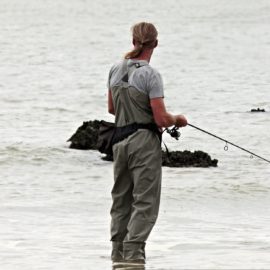
Acy Cooper grew up on the water, breathing in the air of Barataria Bay. As a third-generation shrimper, he feels the industry in his blood, and the beady-eyed, long-bodied crustaceans caught in his trawling nets represent his heritage as well as his livelihood. “My dad taught me how to fish, and I taught my kids how to fish,” said Cooper. “All my friends, we’re a big tight-knit community that fishes together.” Each year, the region’s short, multimillion-dollar brown shrimp season provides an early opportunity for Cooper and his friends to start paying down loans after the winter months and before white shrimp appear in August. But the freshwater infusion from Louisiana’s planned $2 billion Mid-Barataria Sediment Diversion project could cripple chances to catch any “brownies” after it opens.
nola.com
The Mid-Barataria Diversion is a 50 year $50 billion effort to build land and offer mitigations for impacts on the fishing, shrimp, and oyster business that will be impacted by the changes in salinity of the water.
“The fishing industry doesn’t see the payoff here. It’s going to kill us more than it’s going to help anything,” said Cooper, president of the Louisiana Shrimp Association. He said he feels as though the sparsely populated fishing communities of lower Plaquemines Parish, where the diversion is to be built, have been written off. “We have no oil field down here. If you take the moneymaker from down here, what are you going to do to these small communities?”
Barataria Bay has lost more ground that any other area of the state largely due to the levees that prevented Mississippi River silt from draining into it. The Diversion is to replicate this lost silt flow. It will provide a buffer for hurricanes but it will hurt the fishing industry as noted in to Army Corps of Engineers draft environmental impact statement.
“No matter how you look at this, this is going to be a shock treatment to the system,” said Earl Melancon, a biologist for LSU SeaGrant. “Not only in terms of the flora and fauna in the estuaries, but for the people who live and work in the estuary, it’s going to be a shock treatment to them.” In the long term, Melancon said, it’s possible that the basin’s freshwater biodiversity could surpass that of its current state. But at what cost? Crawfish and other freshwater species typically don’t fetch the same price as the oysters or shrimp.
Industry, however, doubts that the assessment truly reflects the damage that will be felt in the fishing industry.
“The freshwater species coming in are not going to be the cash crop that we’re giving up on,” said longtime oyster harvester Mitch Jurisich.
The Corps of Engineers says the water is getting saltier as it becomes more open so loss would occur in anyway. The Corps offered these comments:
The number of shrimp, oysters and large mouth bass are expected to shrink over the next 30 years, and to drop steeply after 2050.
Crabs will likely see a gradual loss, though to a lesser extent.
Productive oyster habitat in Barataria Bay would eventually shift westward into areas newly converted into open water.
By 2070, the eastern half of the project area would be rendered unsuitable for oysters, according to analyses by The Water Institute of the Gulf.
Local opponents accept what the Corps says but rather than the diversion they would prefer a pipe bringing in the silt, a much less effective way to build land.
“We can work with the coast and the changing coast as long as it’s a slow-paced change,” said Jurisich, chair of Louisiana’s Oyster Task Force. “Even at the more rapid pace we’ve been at lately, we can still adapt. You can still time things in a fashion where we don’t lose production.” The state already employs the pipeline tactic — dredging mud and pumping it miles away into wetland areas to build more land — in some parts of its coastal master plan. But the marsh created that way has a limited life span without a ready source of new sediment. Brian Lezina, chief of planning for the state’s Coastal Protection and Restoration Authority, said the Mid-Barataria diversion would be key to extending the life of additional wetlands acreage added to the basin with dredging projects in the near future.
The rebuilding of the land is needed but the impact on the fishing industry is more than they can take. Oysters would be the hardest hit as their habitat would be moved to where no reefs could be built. The white shrimp would have some improvement as they can tolerate fresh water more easier. Brown shrimp would be hurt as they don’t like fresh water. The fishing and game fishing industry might get better as the newly built marsh would be a new area for them to feed.
While many effects of the diversion on fisheries were anticipated ahead of the Corps’ report, Melancon said the draft environmental impact statement gives fishers hard numbers to quantify their loss or gain and provides a jumping-off point for discussions between the commercial fishing industries and the state and federal agencies involved in the project. “It is now in a factual form that they can put their arms around and say, ‘This is what’s going to happen to me’,” he said. “It gives the ability on both sides to say what kind of reality are we really looking at based on these numbers that are nothing more than a scale and can be interpreted based on the person who’s reading it at the time.”
There will be mitigation, millions of dollars for it. The Louisiana Trustees Implementation Group’ denotes the detail on mitigation plans.
Lezina said these mitigation offers are just a starting point based on meetings, focus groups and surveys conducted with hundreds of the basin’s fishers in 2019. He urged the public to specify assistance they would like to see when they submit comments on the Corps’ draft report. “We want to do what’s best for the industry as put forth by the industry,” he said. “The whole goal here is to keep a viable commercial and recreational fishery in coastal Louisiana.”
Computer access hinders many from commenting and one school of thought is that the high cost of mitigation may kill the project.
But litigation to halt the diversion seems almost inevitable. George Ricks, who runs a charter fishing business out of Hopedale and leads the Save Louisiana Coalition, said there’s not enough money in the current diversion plan to pay for the harm it will cause to fishers. “You can’t put a dollar value on culture and heritage,” he said. “Everything we’ve been saying all along, it’s true. The land-building capabilities — that’s uncertain. But now we’re certain about the impacts.”
The question becomes – how badly do we need the land? If the land continues to go what will happen to the fishing industry? If the fishing industry adapts and the land is built, how much will they be impacted? Can we fix every ill that comes from the diversion? These are hard questions.



